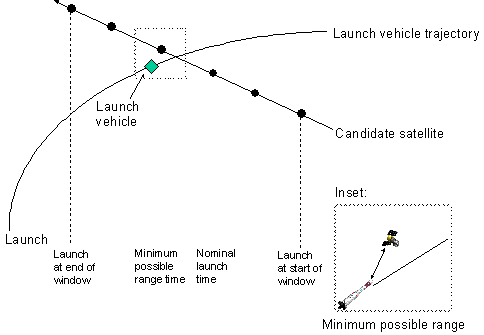Using the Launch Window Analysis Tool
The Launch Window Analysis tool computes close approaches on the selected missile or launch vehicle. To use the Launch Window Analysis tool, highlight the object in the Object Browser and select Launch Window Analysis from the <object> menu.
By default, the tool performs its close approach analysis on the object from which you invoked the tool. You can click the Select Object... button to choose a different object to analyze.
To calculate close approaches for the launch window that you have defined, click the Compute button; a summary of the results will be displayed in the Compute Results field. To set advanced analysis properties, click the Advanced... button. To define display properties of the computation results, click the Graphics... button.
Launch Window
A launch window can be specified for missiles and launch vehicles by editing the Start and Stop fields, or by selecting a time or interval component from the drop-down menu. For more information on the options available for time intervals and start and stop times, see Time Options.
The launch window represents an interval of time when the vehicle may begin its trajectory. The existing ephemeris for the missile or launch vehicle is maintained in the Earth-centered, Earth-fixed reference frame, but the start time of the trajectory is allowed to vary between the start and stop times of the launch window.
In this situation, the position of the reference vehicle is known at a specified time past launch, but the position of the candidate object may be anywhere within a continuous segment defined by the launch window. The minimum possible range is determined for each post-launch moment by locating the time of launch that would result in the objects being the closest. Periods of time when the minimum possible range is less than the specified minimum range may then be mapped into blackout periods in the launch window.

Launch window for missile or launch vehicle
Close approaches are determined for all possible launch times within the window in a single run. If the launch window start and stop times are the same, the launch window is ignored.
Launch windows should be constrained to be smaller than the orbital periods of the candidate satellites. Longer launch windows should be broken up into several smaller intervals.
Range Constraint
In the Max Range field, enter a value corresponding to the minimum allowable distance between the reference object and any other object. This property works by imposing a Max Range constraint on the reference object, but its effect, from a conceptual standpoint, is to define a sphere around the reference object marking the minimum allowable distance between the reference object and other space objects. During analysis, when the Launch Window Analysis Tool finds an object that is within the range specified in this field, the object and the associated time are flagged and displayed.
Besides imposing a Max Range constraint on the reference object, the Launch Window Analysis Tool removes other constraints on that object. If you plan on using an object that has been the subject of a close approach analysis in other computations, you should restore the desired constraints to that object.
Ephemeris Source for Secondaries
Secondaries are objects that present either a potential risk of collision with, or an unacceptable close approach to, the primary object that you are analyzing with the Launch Window Analysis tool.
Select Use SGP4 with TLE file to search an external file of GP data (like TLEs) that use the SGP4 propagator to calculate their ephemerides for the close approach analysis. By default, the Launch Window Analysis tool searches the stkAllTLE Satellite Database. To change the external file, enter the new external name and path in the
File Name field or click the ![]() button to browse for a GP data file.
button to browse for a GP data file.
Select Cross Reference to report conjunctions using the Common Name for the satellite. In the Cross Ref Name field, select a relatively comprehensive database file (such as stkAllTLE.sd) by entering the name and path or by clicking ![]() to browse to one. When the Close Approach Tool finds a close approach candidate in the external GP data file, it checks the cross reference file for a corresponding entry. If there is one, and the Add Conjuncting Satellites option has been selected, the satellite will be brought into the scenario under its common name and information will be entered on the Description page of the Basic properties for that satellite (otherwise, the satellite will be brought in under its SSC number).
to browse to one. When the Close Approach Tool finds a close approach candidate in the external GP data file, it checks the cross reference file for a corresponding entry. If there is one, and the Add Conjuncting Satellites option has been selected, the satellite will be brought into the scenario under its common name and information will be entered on the Description page of the Basic properties for that satellite (otherwise, the satellite will be brought in under its SSC number).
Select Use External Ephemeris files to specify a set of ephemeris files (instead of GP data (like TLEs)) to reference for the close approach analysis. Define the folder that contains the ephemeris files that you want to use by selecting Use Scenario Folder or by clicking the ![]() button and browsing to the folder.
button and browsing to the folder.
Reports
Click the Blackouts button to generate a report of the blackout intervals that the tool has computed, and the Clear Intervals button to generate a report of the clear launch intervals.